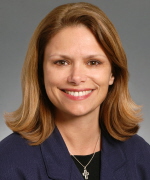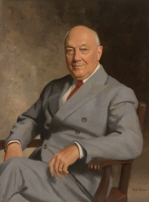Minnesota’s 6th CD: The Most Politically Volatile District in the State Since 1944 DFL Merger
District has switched parties eight times since DFL merger in April 1944, including five times since 1980 – twice as many as any other district in Minnesota

A Smart Politics analysis of 275 general and special election U.S. House contests in Minnesota since the DFL merger in 1944 finds that the 6th Congressional District has had more turnover in party control than any other district in the Gopher State.
Since the DFL merger in April 1944, partisan control of the 6th CD has changed eight times – accounting for nearly 30 percent of the 28 such flips that have occurred in congressional districts across the state during the 64-year span through the 2008 election cycle.
The 6th CD has flipped twice as many times as the next most volatile district in the Gopher State – the 3rd CD, which changed party control four times during this period.
However, the 3rd CD has remained Republican since 1960 with the election of Clark MacGregor (then Bill Frenzel, Jim Ramstad, and Erik Paulsen), whereas the 6th CD has flipped seven times since 1966 and five times since 1980 – or approximately one out of every three election cycles.
Overall, the 6th CD has changed partisan hands in 24.2 percent of the 33 election cycles since 1944. The statewide average in Minnesota is just 10.2 percent.
As depicted by the table below, each congressional district has witnessed at least one partisan switch over the last seven decades since the merger.
Change in Partisan Control of Minnesota’s Congressional Districts, 1944-2008
|
District
|
#
|
Races
|
%
|
Years
|
|
1st
|
3
|
34
|
8.8
|
1982, 1994, 2006
|
|
2nd
|
2
|
33
|
6.1
|
1992, 2000
|
|
3rd
|
4
|
33
|
12.1
|
1944, 1946, 1948, 1960
|
|
4th
|
3
|
33
|
9.1
|
1944, 1946, 1948
|
|
5th
|
1
|
33
|
3.0
|
1962
|
|
6th
|
8
|
33
|
24.2
|
1948, 1966, 1974, 1980, 1982, 1992, 1994, 2002
|
|
7th
|
3
|
34
|
8.8
|
1970, 1977, 1990
|
|
8th
|
1
|
33
|
3.0
|
1946
|
|
9th
|
3
|
9
|
33.3
|
1944*, 1954, 1958
|
|
Total
|
28
|
275
|
10.2
|
|
*The flip in 1944 in the 9th CD was the result of Farmer-Laborite Harold Hagen changing his party affiliation to the GOP. Note: The boundaries of all Minnesota’s districts have been tweaked over the decades through redistricting (and reapportionment – Minnesota’s 9th CD was eliminated following the 1960 U.S. Census). For the time period under analysis, however, the 6th CD has been drawn largely in the region north of the Twin Cities metro area. Data includes special elections. Table compiled by Smart Politics.

Knutson, former Majority Whip of the House, was first elected in 1916 and served the district for 32 consecutive years before losing to DFLer Fred Marshall by 3.4 points in 1948.
Marshall then served the 6th CD for seven terms, but was not a candidate for reelection in 1962, when future Lieutenant Governor Alec Olson won the open seat race to keep control of the district in the hands of the DFL.
Olson, however, was unseated in 1966 when GOP State Senate Majority Leader John Zwach defeated him by 2.8 points during the Republican tidal wave that November (the GOP gained 47 seats nationwide that cycle).
Zwach won his next three campaigns but was not a candidate for reelection in 1974, when the open seat was won by DFLer Richard Nolan by 10.8 points over John Grunseth. (Nolan had lost to Zwach by just 2.0 points in 1972).
Nolan won reelection in 1976 and 1978 but was not a candidate for reelection in 1980 when Vin Weber, the second youngest Minnesotan ever elected to the U.S. House at the age of 28, took the seat back for the GOP with a 5.4-point win over DFLer Archie Baumann.
After redistricting following the 1980 Census, Weber won a second term in the state’s 2nd CD, leaving Republican Arlen Erdahl (previously of the 1st CD) to fend for his political life in the 6th. Erdahl went down to defeat to DFL State Senator Gerry Sikorski by 1.6 points for the third change in party control in the district over the last five election cycles.
Sikorski won reelection in the 6th in 1984, 1986, 1988, and 1990, but was upended after redistricting in 1992 by future Republican U.S. Senator Rod Grams, who defeated Sikorski by 11.2 points with just 44.4 percent of the vote. Future (appointed) U.S. Senator Dean Barkley won 16.1 percent as an independent in that contest.

Luther would survive more close calls – including victories over future Congressman John Kline by 4.0 points in 1998 and 1.6 points in 2000.
Redistricting after the 2000 Census forced Luther to run in the 2nd CD in 2002 (whereupon he finally lost to Kline), and a newly-open 6th CD brought Republicans back to power with the election of Mark Kennedy in a 22.2-point landslide over DFLer Janet Robert.
Republicans have held the 6th CD ever since. However, the district provided the narrowest margin of victory in the state in 2004 (8.1 points) and 2008 (3.0 points) and second narrowest in 2006 (8.0 points).
In fact, Michele Bachmann’s victory in 2008 was the narrowest of any Republican incumbent reelected to the U.S. House in the nation that cycle and the fifth narrowest victory for the GOP overall.
Despite the Republican leanings of the district and Bachmann’s fundraising prowess, the historical volatility of the 6th CD is something the Clark campaign can use to further motivate its troops heading into the next few critical months of the campaign.
Follow Smart Politics on Twitter.

Eric,
Clearly you have never heard of something called re-districting. The methodological flaws of what you write are so off to be stunningly embarsssing to your competence to turn on a computer, much less analyze the time of day.
Have you heard of the following that each indvidually invalidates this column?
1) redistricting
2) Demographic changes
3) voter realignment
But apparently you base you analysis on numerology of the number 6.
> Clearly you have never heard of something called
> re-districting.
Frank: as written in the note to the table of data:
“Note: The boundaries of all Minnesota’s districts have been tweaked over the decades through redistricting (and reapportionment – Minnesota’s 9th CD was eliminated following the 1960 U.S. Census). For the time period under analysis, however, the 6th CD has been drawn largely in the region north of the Twin Cities metro area.”
Redistricting, of course, affects every Minnesota district, not just the 6th.
> Have you heard of the following that each indvidually
> invalidates this column?
> 2) Demographic changes
> 3) voter realignment
As you can see from the table above, such changes (as well as other factors) can indeed cause shifts in the electorate, and, thus lead to the defeat of an incumbent in the same redistricting period.
For example: the 3rd CD flipped three times in the 1940s (1944, 1946, 1948), the 4th CD flipped three times in the 1940s (1944, 1946, 1948), the 9th CD flipped twice in the 1950s (1954, 1958), and the 6th CD shifted twice after the 1972 redistricting (1974 and 1980) and twice after the 1992 redistricting (1992, 1994).
I met (former Congressman) Richard Nolan in Abu Dhabi and we became good friends, but we, however, lost contact in 1990. Is there any email address available through which I may be able to contact him?
Your kind assistance is highly appreciated.
Best regards
Karl May
Philippines
1. It would behoove all (well, those of us who even casually care) if each district/constituency were given proper names (e.g. “Oxford East” of the UK; “Mayo” of Australia) rather than (changeable and forgettable) numbers. As to the primary premise of the piece, the Volatile Sixth has not quite been such; since the current configuration (a collection of north-and-east suburbs of the vast Twin Cities metropolitan region) commenced for the 2002 midterm cycle, it has never elected a DEM, not even in 2006 or ’08.
2. Of the venues that are traceable (i.e. as defined by composition, not numerical designation) the most “volatile” is the “Western Tier” constituency (CD-07, formerly -09), which now includes the bulk of the old “Southwest” seat (‘6’ from ???? through 1980 cycle; ‘2’ from 1982 through 2000); it has switched in ’44 (party switch, as noted in extremely fine print), ’54, ’58 (“Coya, Come Home”), ’70, ’77 (by-election), and 1990 (taxpayer-funded extramarital affair; yet another domestic discord!). This cycle may produce another flip – whether or nor Peterson is the D nominee, and regardless of national trends or districtwide gubernatorial results.